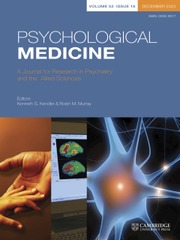Crossref Citations
This article has been cited by the following publications. This list is generated based on data provided by
Crossref.
Boyd‐Ball, Alison J.
Manson, Spero M.
Noonan, Carolyn
and
Beals, Janette
2006.
Traumatic events and alcohol use disorders among American Indian adolescents and young adults.
Journal of Traumatic Stress,
Vol. 19,
Issue. 6,
p.
937.
Tang, Betty
Jamieson, Ellen
Boyle, Michael
Libby, Anne
Gafni, Amiram
and
MacMillan, Harriet
2006.
The influence of child abuse on the pattern of expenditures in women's adult health service utilization in Ontario, Canada.
Social Science & Medicine,
Vol. 63,
Issue. 7,
p.
1711.
O’connor, Maja
Lasgaard, Mathias
Spindler, Helle
and
Elklit, Ask
2007.
The impact of different diagnostic criteria on PTSD prevalence.
Nordic Psychology,
Vol. 59,
Issue. 4,
p.
317.
2007.
Normal and Abnormal Fear and Anxiety in Children.
p.
299.
Al-Modallal, Hanan
Peden, Ann
and
Anderson, Debra
2008.
Impact of Physical Abuse on Adulthood Depressive Symptoms Among Women.
Issues in Mental Health Nursing,
Vol. 29,
Issue. 3,
p.
299.
For the Cedar Project Partnership
Pearce, Margo E.
Christian, Wayne M.
Patterson, Katharina
Norris, Kat
Moniruzzaman, Akm
Craib, Kevin J.P.
Schechter, Martin T.
and
Spittal, Patricia M.
2008.
The Cedar Project: Historical trauma, sexual abuse and HIV risk among young Aboriginal people who use injection and non-injection drugs in two Canadian cities.
Social Science & Medicine,
Vol. 66,
Issue. 11,
p.
2185.
Hettema, John M.
2008.
The nosologic relationship between generalized anxiety disorder and major depression.
Depression and Anxiety,
Vol. 25,
Issue. 4,
p.
300.
Probst, Janice C.
Wang, Jong-Yi
Martin, Amy B.
Moore, Charity G.
Paul, Barbara Morningstar
and
Samuels, Michael E.
2008.
Potentially Violent Disagreements and Parenting Stress Among American Indian/Alaska Native Families: Analysis Across Seven States.
Maternal and Child Health Journal,
Vol. 12,
Issue. S1,
p.
91.
Libby, Anne M.
Orton, Heather D.
Beals, Janette
Buchwald, Dedra
and
Manson, Spero M.
2008.
Childhood abuse and later parenting outcomes in two American Indian tribes.
Child Abuse & Neglect,
Vol. 32,
Issue. 2,
p.
195.
Yen, Cheng-Fang
Yang, Mei-Sang
Yang, Ming-Jen
Su, Yi-Ching
Wang, Mei-Hua
and
Lan, Chu-Mei
2008.
Childhood physical and sexual abuse: Prevalence and correlates among adolescents living in rural Taiwan.
Child Abuse & Neglect,
Vol. 32,
Issue. 3,
p.
429.
Jiang, Luohua
Beals, Janette
Whitesell, Nancy R.
Roubideaux, Yvette
and
Manson, Spero M.
2008.
Stress Burden and Diabetes in Two American Indian Reservation Communities.
Diabetes Care,
Vol. 31,
Issue. 3,
p.
427.
Natrella, Laura
Bolognesi, Enrica
Lo Sauro, Carolina
Batini, Sara
and
Faravelli, Carlo
2009.
Abuso infantile e disturbi psichiatrici: rassegna.
Quaderni Italiani di Psichiatria,
Vol. 28,
Issue. 2,
p.
59.
Hettema, John M.
2010.
Diagnostic Issues in Depression and Generalized Anxiety Disorder: Refining the Research Agenda for DSM-V.
p.
15.
Klauke, Benedikt
Deckert, Jürgen
Reif, Andreas
Pauli, Paul
and
Domschke, Katharina
2010.
Life events in panic disorder-an update on “candidate stressors”.
Depression and Anxiety,
Vol. 27,
Issue. 8,
p.
716.
Zahradnik, Marc
Stewart, Sherry H.
Sherry, Simon B.
Stevens, Doreen
and
Wekerle, Christine
2011.
Posttraumatic stress hyperarousal symptoms mediate the relationship between childhood exposure to violence and subsequent alcohol misuse in Mi'kmaq youth.
Journal of Traumatic Stress,
Vol. 24,
Issue. 5,
p.
566.
Roberts, A. L.
Gilman, S. E.
Breslau, J.
Breslau, N.
and
Koenen, K. C.
2011.
Race/ethnic differences in exposure to traumatic events, development of post-traumatic stress disorder, and treatment-seeking for post-traumatic stress disorder in the United States.
Psychological Medicine,
Vol. 41,
Issue. 1,
p.
71.
Bombay, Amy
Matheson, Kimberly
and
Anisman, Hymie
2011.
The impact of stressors on second generation Indian residential school survivors.
Transcultural Psychiatry,
Vol. 48,
Issue. 4,
p.
367.
Wang, JianLi
and
Schmitz, Norbert
2011.
Does job strain interact with psychosocial factors outside of the workplace in relation to the risk of major depression? The Canadian National Population Health Survey.
Social Psychiatry and Psychiatric Epidemiology,
Vol. 46,
Issue. 7,
p.
577.
Mota, Natalie
Elias, Brenda
Tefft, Bruce
Medved, Maria
Munro, Garry
and
Sareen, Jitender
2012.
Correlates of Suicidality: Investigation of a Representative Sample of Manitoba First Nations Adolescents.
American Journal of Public Health,
Vol. 102,
Issue. 7,
p.
1353.
Li, Nan
Ahmed, Saifuddin
and
Zabin, Laurie S.
2012.
Association Between Childhood Sexual Abuse and Adverse Psychological Outcomes Among Youth in Taipei.
Journal of Adolescent Health,
Vol. 50,
Issue. 3,
p.
S45.

